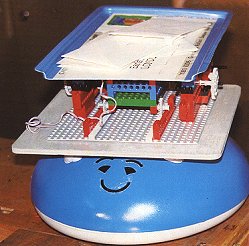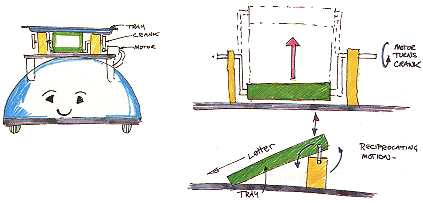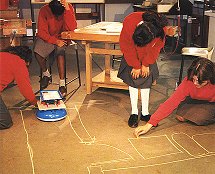
|
Feedback Form

MAIL DELIVERY ROAMER
 Pete
Jewett, a Technology teacher at Burntwood School, Tooting, introduced
the Roamer to a group of 14 year olds. Here he documents the project.
Pete
Jewett, a Technology teacher at Burntwood School, Tooting, introduced
the Roamer to a group of 14 year olds. Here he documents the project.
Burntwood is a large Secondary school for girls in South West London. We have been running National Curriculum Technology as a pilot school since 1989.
At Burntwood we decided we needed to introduce the concepts of Control Technology to our Year 9 pupils. Burntwood started National Curriculum Technology a year early so these pupils were the first to go through our Technology Program. They had no previous experience of computer programming or the application of control within a design brief. What was needed was a simple basic unit that could be added to as needed to produce a total package that fulfilled the Attainment Target objectives.
As ours is a recently established department suffering the same shortages of resources and cash as most others the task did not seem altogether easy. However, the Roamer proved capable of fulfilling most of our requirements.

A group of students decided that they would like to develop a form of Mail Delivery/Retrieval system. The idea was for the system to be used in the homes of people with restricted movement. Roamer appeared to give then an ideal base from which to work with their ideas.
Their introduction to Roamer was brief, it took me about two minutes to show them the demonstration program and then to show them how to send it forward and how to get it to return. The two minutes was not exactly my idea. It soon turned out my monopoly on the Roamer had been instantly broken and for the next hour my services were barely needed. By the end of that time the students were sending Roamer on complex trails around the room and experimenting with the sound generator. In short, they were hooked.
My next problem was to get them to put Roamer down for long enough to sort out what they were going to do with it. Their original idea was to have their device sitting at the front door under the letter box waiting to catch any falling letters. Once the letters had been "caught", the device would proceed down a hallway and deliver them to a coffee table in the living room.

This was first shown as a series of sketches and later displayed as a flow diagram (plenty of opportunities for different forms of graphics). It soon became clear through this form of sketch development that several mechanisms and structures would be needed as well as some means to "tell" Roamer that a letter had arrived.
At this point we carried out a little work using Roamer's control interface. Experiments were carried out with motors and sensors, we were glad to find that the output from Roamer was compatible with Lego Technic motors as this gave us a basis for constructing the mechanisms.
The students then started work on their prototypes and test programs. They went through several different mechanisms before they finally produced one that could do the job. That path was immensely interesting as it took them from simple pullies and rack and pinions to reciprocating motion and compound gear trains.
Mechanism design and control programming went hand in hand on this project. This was possibly one of the most rewarding areas from a learning point of view. Through trial and error the girls learnt that they could run a motor in two directions by using two output lines. They discovered they could also run motors in parallel and that this could result in the motors not producing enough torque to work their specified mechanism.

This may seem too technical for some students. In fact this was not the case. All the students were concerned with the overall design and planning. Once the specifications were set they decided upon responsibilities within the group, one of those being the outward appearance of their device (although Roamer was at the centre of their design, the final product was definitely their device). Jackets had to be sprayed and decorated to go with the theme of the brief and platforms had to be produced to mount the mechanism on.
Within one integrated project we found that there were enough areas of design to keep most specialists occupied. That is one of the many advantages of Roamer, it can be used to cover many areas within National Curriculum Technology. Our project managed to cover all the Attainment Targets including Information Technology.
Through using the Roamer the students at Burntwood have discovered and remembered far more about computers, control and mechanisms than I could have taught them in the same amount of time through formal lessons. To me the most important feature was the hands on capability and the potential for learning that this provides.
A definite bonus is the image that a Roamer gives. Many Technologists will fondly remember Big Trak - a great idea that caused many moral problems. Roamer on the other hand does not pretend to shoot anything or anybody, it does not resemble a military vehicle in any way and as such appeals equally to girls, boys and teachers. Roamer's design is that of current robots, purely functional, it gives the student a far more accurate picture of robotics. I found with our project that Roamer's neutral design leaves the students free to interpret any form they wish, and they will!
| Back |
|---|